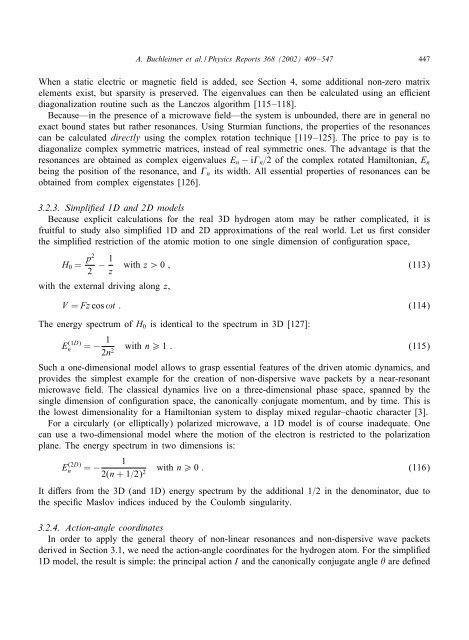Non-dispersive wave packets in periodically driven quantum systems
Non-dispersive wave packets in periodically driven quantum systems
Non-dispersive wave packets in periodically driven quantum systems
Create successful ePaper yourself
Turn your PDF publications into a flip-book with our unique Google optimized e-Paper software.
A. Buchleitner et al. / Physics Reports 368 (2002) 409–547 447<br />
When a static electric or magnetic eld is added, see Section 4, some additional non-zero matrix<br />
elements exist, but sparsity is preserved. The eigenvalues can then be calculated us<strong>in</strong>g an e cient<br />
diagonalization rout<strong>in</strong>e such as the Lanczos algorithm [115–118].<br />
Because—<strong>in</strong> the presence of a micro<strong>wave</strong> eld—the system is unbounded, there are <strong>in</strong> general no<br />
exact bound states but rather resonances. Us<strong>in</strong>g Sturmian functions, the properties of the resonances<br />
can be calculated directly us<strong>in</strong>g the complex rotation technique [119–125]. The price to pay is to<br />
diagonalize complex symmetric matrices, <strong>in</strong>stead of real symmetric ones. The advantage is that the<br />
resonances are obta<strong>in</strong>ed as complex eigenvalues En − i n=2 of the complex rotated Hamiltonian, En<br />
be<strong>in</strong>g the position of the resonance, and n its width. All essential properties of resonances can be<br />
obta<strong>in</strong>ed from complex eigenstates [126].<br />
3.2.3. Simpli ed 1D and 2D models<br />
Because explicit calculations for the real 3D hydrogen atom may be rather complicated, it is<br />
fruitful to study also simpli ed 1D and 2D approximations of the real world. Let us rst consider<br />
the simpli ed restriction of the atomic motion to one s<strong>in</strong>gle dimension of con guration space,<br />
H0 = p2<br />
2<br />
− 1<br />
z<br />
with the external driv<strong>in</strong>g along z,<br />
with z¿0 ; (113)<br />
V = Fz cos !t : (114)<br />
The energy spectrum of H0 is identical to the spectrum <strong>in</strong> 3D [127]:<br />
E (1D)<br />
n<br />
= − 1<br />
with n ¿ 1 : (115)<br />
2n2 Such a one-dimensional model allows to grasp essential features of the <strong>driven</strong> atomic dynamics, and<br />
provides the simplest example for the creation of non-<strong>dispersive</strong> <strong>wave</strong> <strong>packets</strong> by a near-resonant<br />
micro<strong>wave</strong> eld. The classical dynamics live on a three-dimensional phase space, spanned by the<br />
s<strong>in</strong>gle dimension of con guration space, the canonically conjugate momentum, and by time. This is<br />
the lowest dimensionality for a Hamiltonian system to display mixed regular–chaotic character [3].<br />
For a circularly (or elliptically) polarized micro<strong>wave</strong>, a 1D model is of course <strong>in</strong>adequate. One<br />
can use a two-dimensional model where the motion of the electron is restricted to the polarization<br />
plane. The energy spectrum <strong>in</strong> two dimensions is:<br />
E (2D) 1<br />
n = −<br />
with n ¿ 0 : (116)<br />
2(n +1=2) 2<br />
It di ers from the 3D (and 1D) energy spectrum by the additional 1=2 <strong>in</strong> the denom<strong>in</strong>ator, due to<br />
the speci c Maslov <strong>in</strong>dices <strong>in</strong>duced by the Coulomb s<strong>in</strong>gularity.<br />
3.2.4. Action-angle coord<strong>in</strong>ates<br />
In order to apply the general theory of non-l<strong>in</strong>ear resonances and non-<strong>dispersive</strong> <strong>wave</strong> <strong>packets</strong><br />
derived <strong>in</strong> Section 3.1, we need the action-angle coord<strong>in</strong>ates for the hydrogen atom. For the simpli ed<br />
1D model, the result is simple: the pr<strong>in</strong>cipal action I and the canonically conjugate angle are de ned











